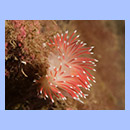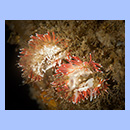- Kingdom: Animalia
- Phylum: Mollusca
- Class: Gastropoda
- Subclass: Heterobranchia
- Order: Nudibranchia
- Suborder: Dexiarchia
- Infraorder: Aeolidida
- Superfamily: Flabellinoidea
- Family: Flabellinidae
- Scientific name: Carronella pellucida
- Norwegian: rød frynsesnegl
Characteristics:
The white, translucent body can grow to a length of 4 cm. The white tipped cerata are colored red by the digestive gland. The rhinophores are wrinkled. There are white pigmentation on the tentacles. Some of the Flabellinoidea species are easily confused:
- F. browni has smooth or slightly wrinkled rhinophores. The cerata are arranged in groups rather then rows. There is a white pigmented ring around the tip of the cerata. There is not a pink tint on the tentacles.
- M. gracilis does not exceed a length of 15 mm. The cerata is is usually arranged in two, but sometimes as many as five rows. The rhinophores are smooth.
- B. nobilis has rounded papillae on the rhinophores. The cerata are not split in groups.
- C. verrucosa has wrinkled rhinophores, usually with a white pigmented line. There may be a pink tint on the white-tipped cerata. Individuals with long cerata may be confused with many of the other Flabellina species.
Habitat:
It is often seen on current exposed locations, feeding on hydroids, like many other members of the Flabellinidae family. It lives from just under the tidal zone and down to approximately 120 meters.
Distribution:
This nudibranch is known from both the eastern and western parts of the North Atlantic Ocean.








